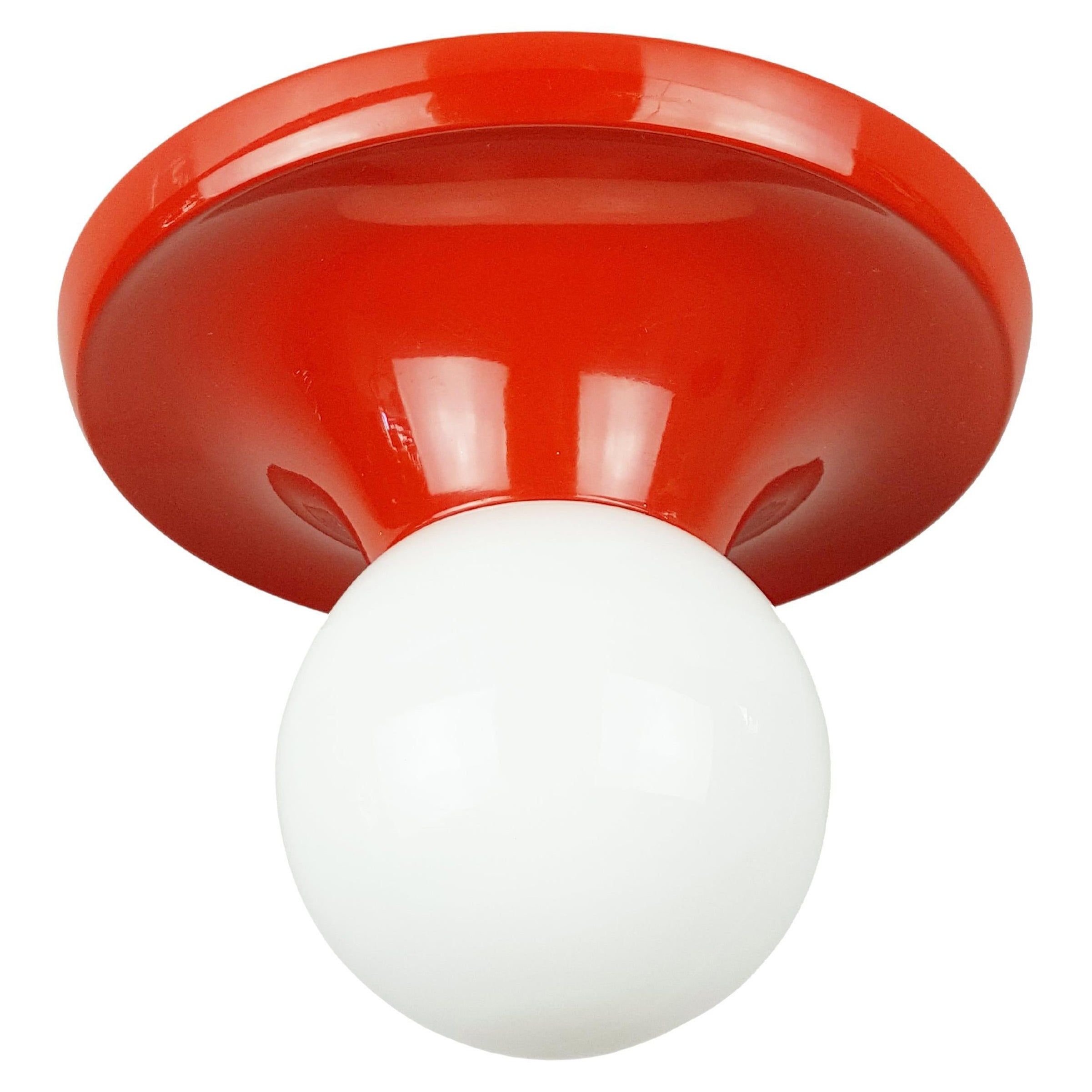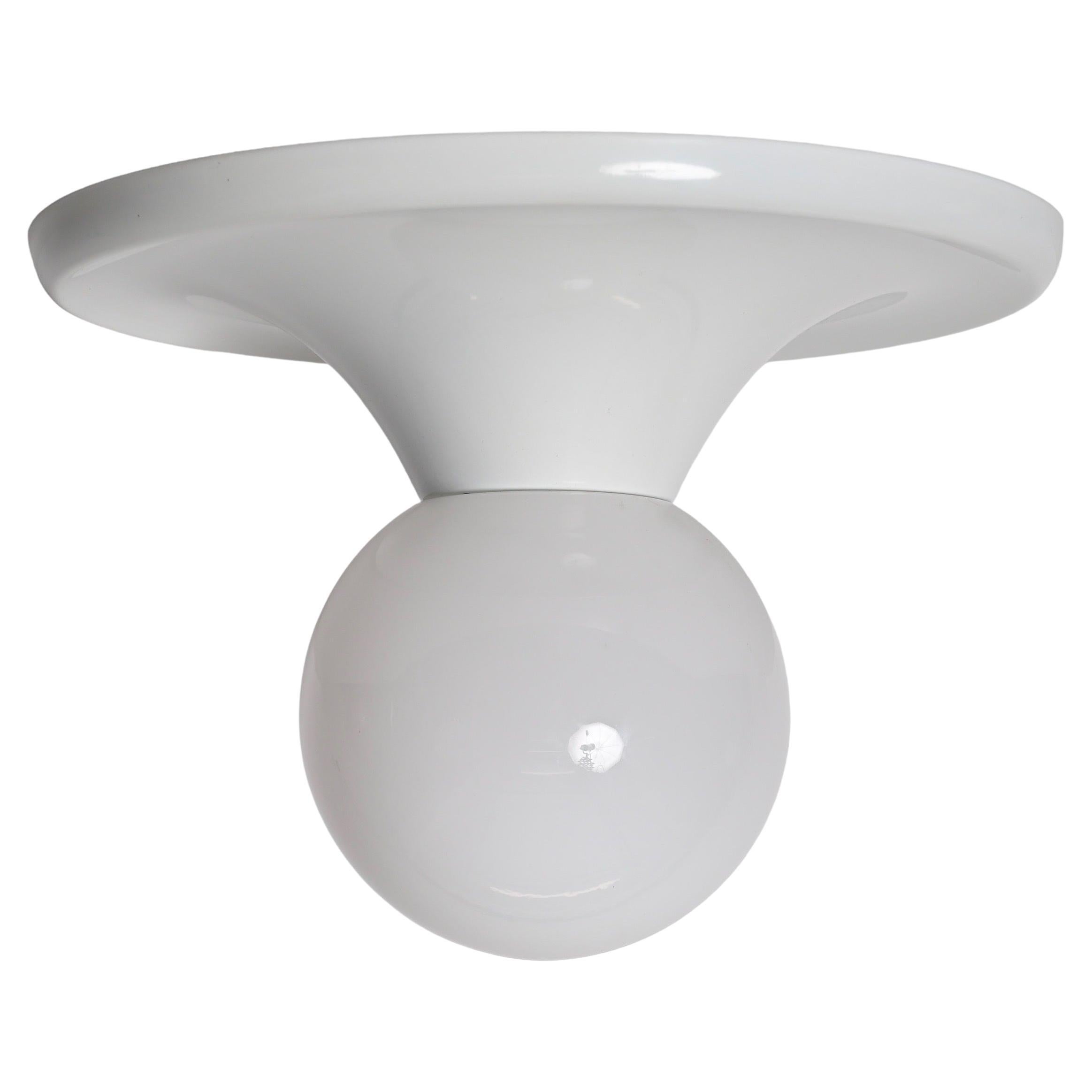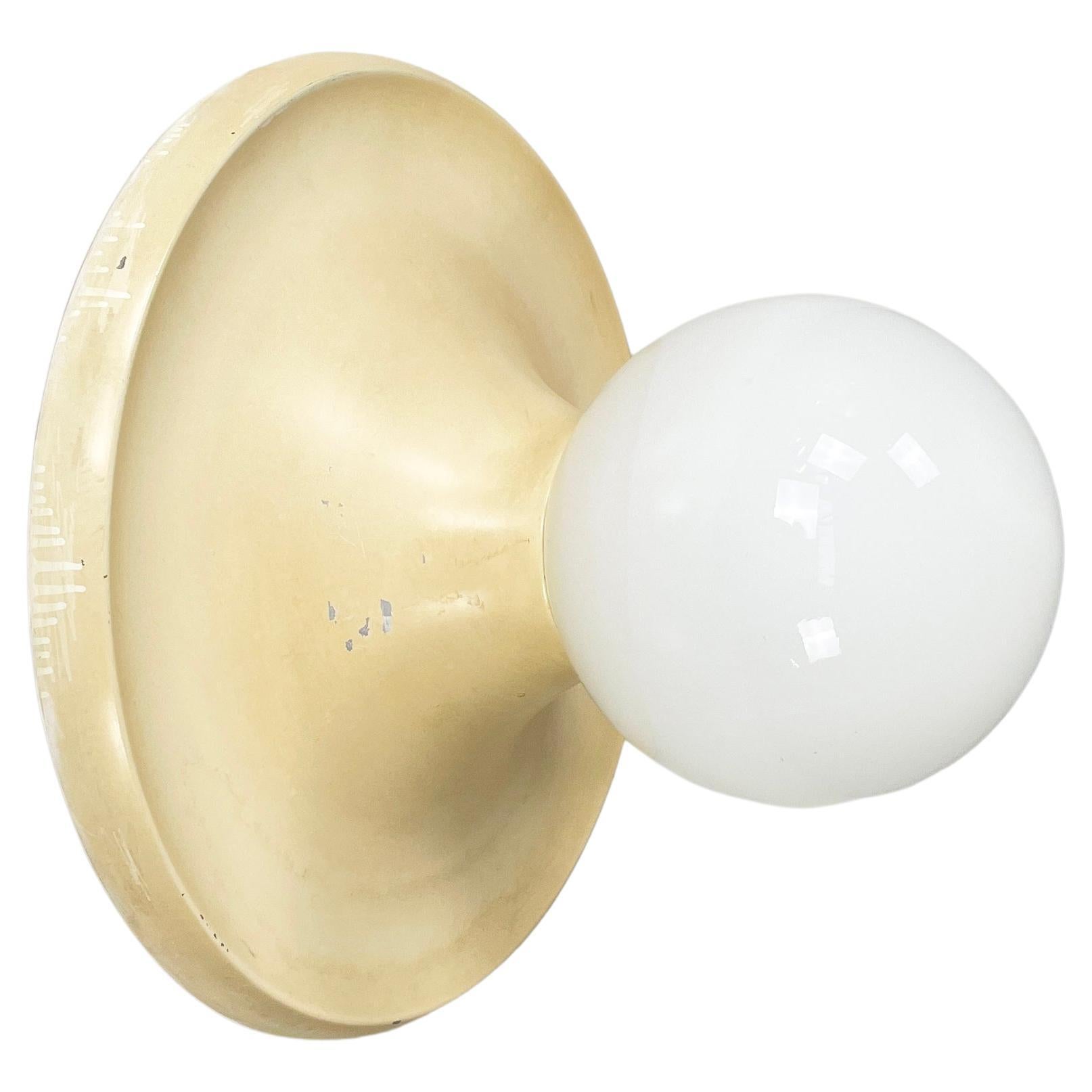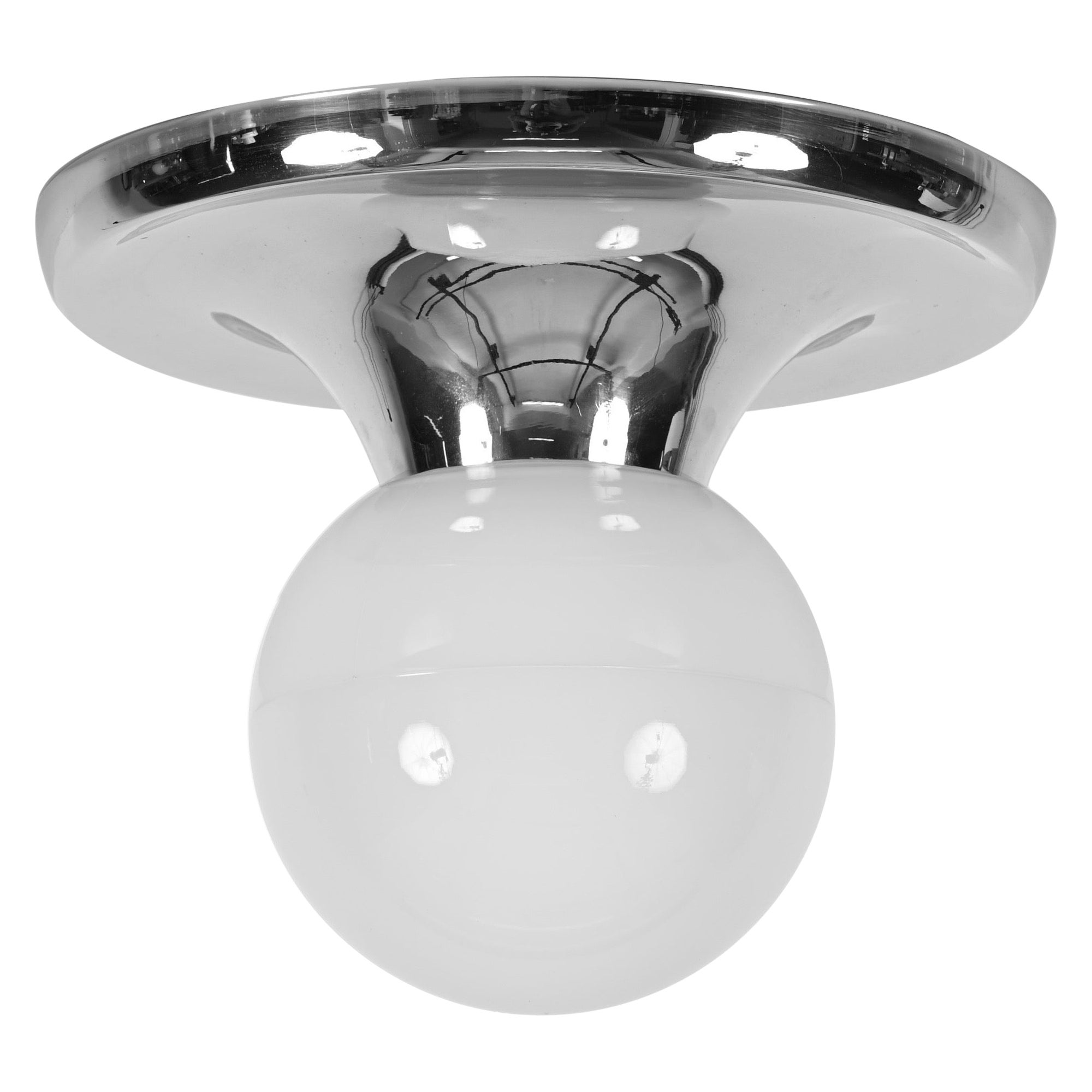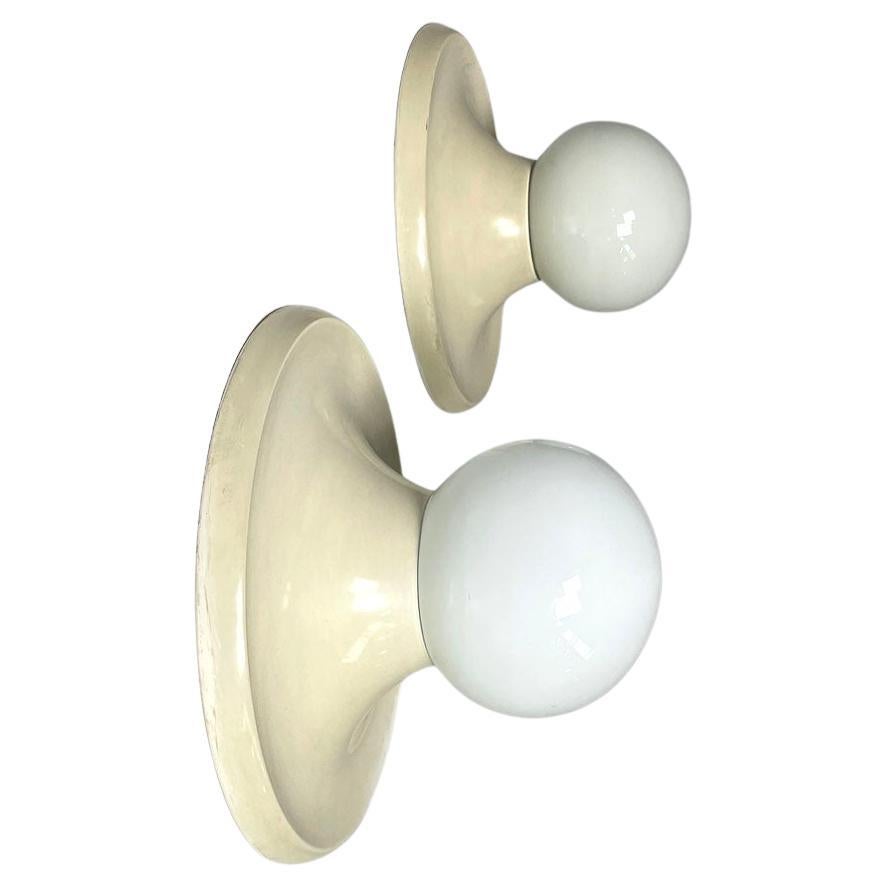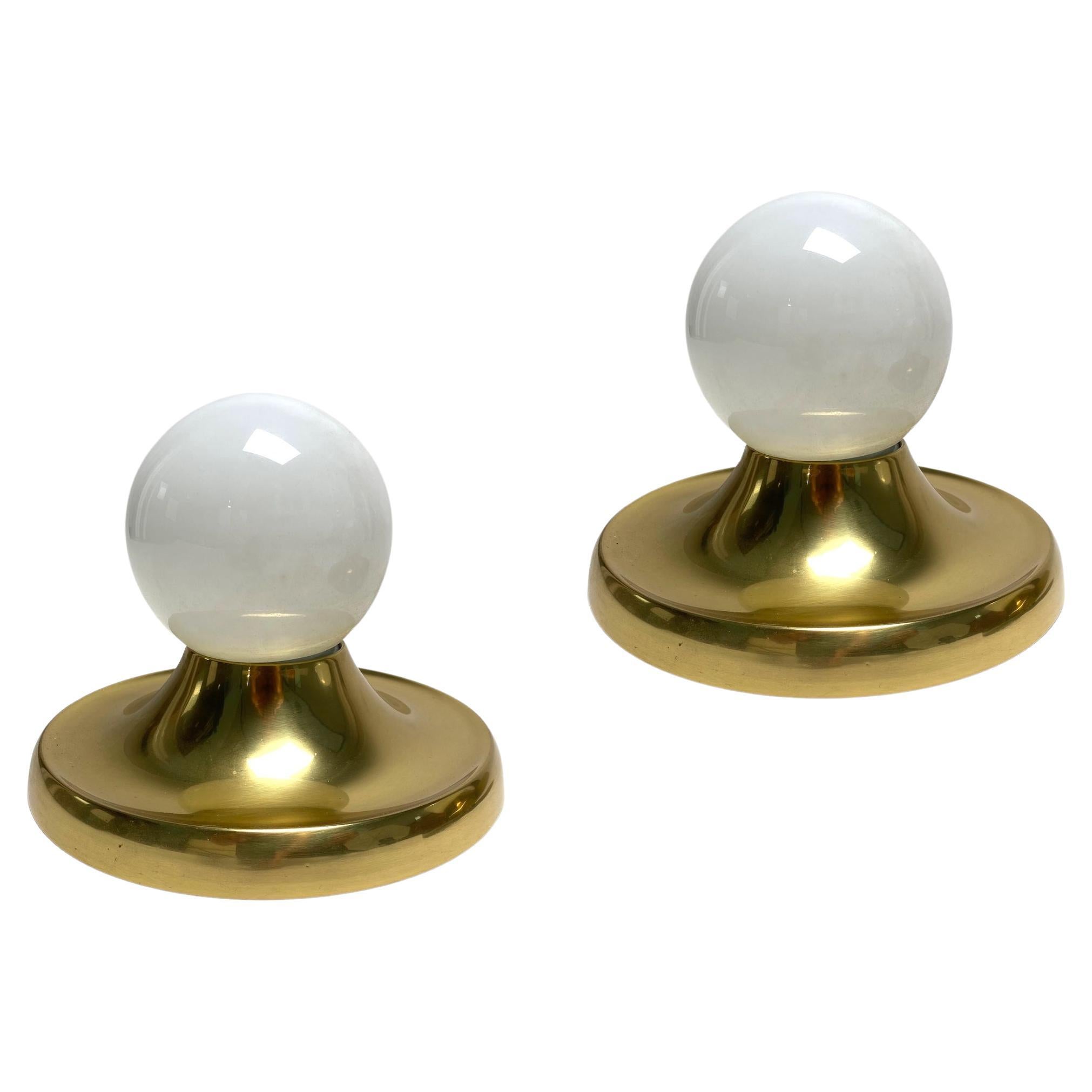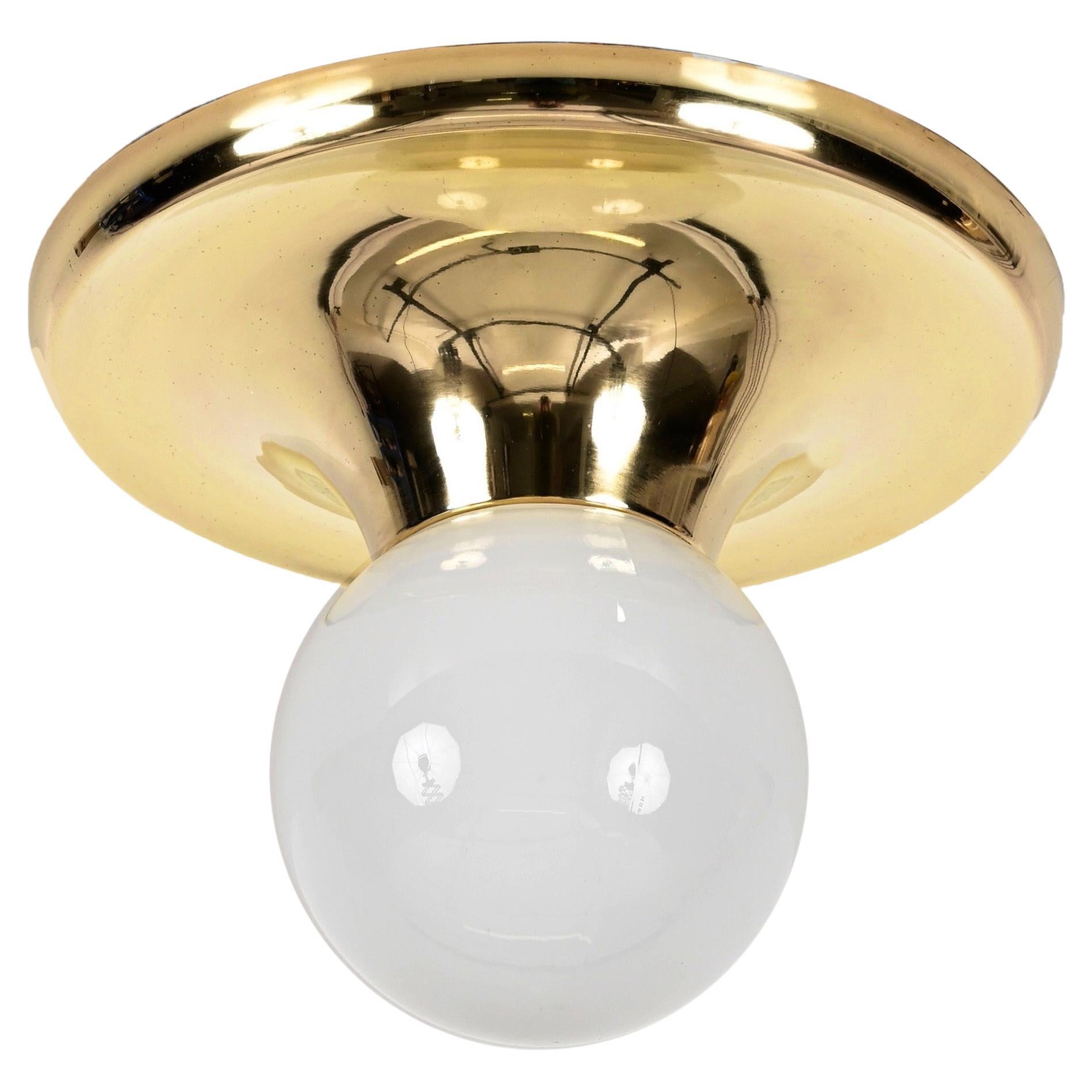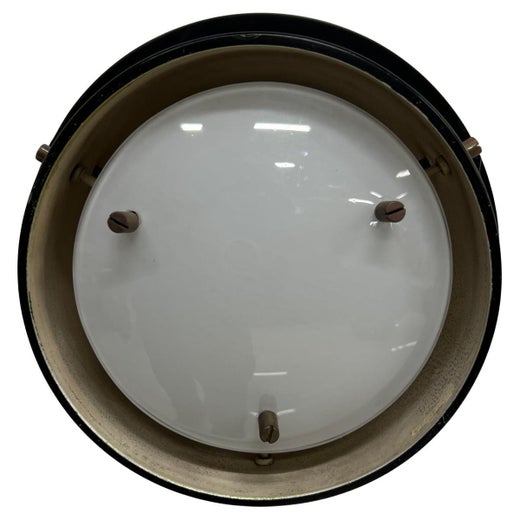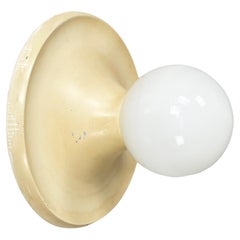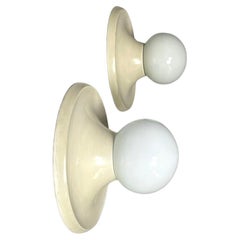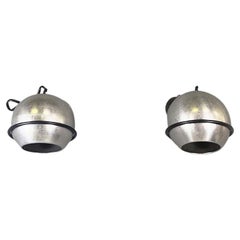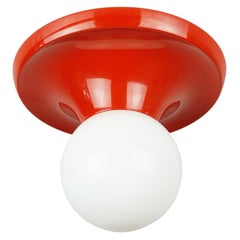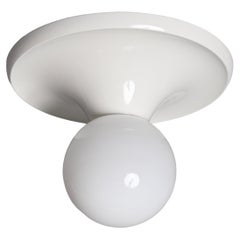
Italy Midcentury Wall Light Balum 230 Ligh Ball by Castiglioni Arteluce, 1960s
View Similar Items
Italy Midcentury Wall Light Balum 230 Ligh Ball by Castiglioni Arteluce, 1960s
About the Item
- Creator:Achille & Pier Giacomo Castiglioni (Designer),Arteluce (Manufacturer)
- Dimensions:Height: 12.21 in (31 cm)Diameter: 16.54 in (42 cm)
- Sold As:Set of 3
- Style:Mid-Century Modern (Of the Period)
- Materials and Techniques:
- Place of Origin:
- Period:
- Date of Manufacture:1960s
- Condition:Very good conditions, light signs of ageing.
- Seller Location:MIlano, IT
- Reference Number:1stDibs: LU4860233916442
Arteluce
The lighting maker Arteluce was one of the companies at the heart of the creative explosion in postwar Italian design. The firm’s founder and guiding spirit, Gino Sarfatti (1912–85), was an incessant technical and stylistic innovator who almost single-handedly reinvented the chandelier as a modernist lighting form.
Sarfatti attended the University of Genoa to study aeronautical engineering but was forced to drop out when his father’s company went out of business. His mechanical instincts led him to turn his attention to lighting design — and he founded Arteluce as a small workshop in Milan in 1939. Sarfatti’s father was a Jew, so the family fled to Switzerland in 1943, but after the war — largely thanks to Sarfatti’s insistence on efficiency of design and manufacture — Arteluce quickly established itself as a top firm. Though Sarfatti continued as chief designer through the 1950s and ’60s, he also enlisted other designers such as Franco Albini and Massimo Vignelli to contribute work. Sarfatti sold Arteluce to FLOS — a rival Italian lighting maker — in 1973 and retired to pursue a more traditional avocation: collecting and dealing rare postage stamps.
Sarfatti is regarded by many collectors as a pioneer of minimalist design. He pared down his lighting works to their essentials, focusing on practical aspects such as flexibility of use. His most famous light, the 2097 chandelier, is a brilliant example of reductive modernist design, featuring a central cylinder from which branches numerous supporting fixtures extending like spokes on a wheel. Similarly, his 566 table lamp is a simple canister, able to be raised or lowered on a stem, holding a half-chrome bulb. Despite the marked functionality of his designs, Sarfatti did have a sprightly side: His 534 table lamp, with its cluster of rounded enameled shades, resembles a vase full of flowers, the Sputnik chandelier (model 2003) was inspired by fireworks and the brightly colored plastic disks of the 2072 chandelier look like lollipops. No matter the style, Sarfatti concentrated first and foremost on the character of light created — and any Arteluce lamp is a modernist masterpiece.
- Italian mid-century Wall light Light Ball by Castiglioni brothers for Flos 1960sBy Achille & Pier Giacomo Castiglioni, FlosLocated in MIlano, ITItalian mid-century modern Wall light Light Ball by Castiglioni brothers for Flos 1960s Elegant Wall or ceiling lamp mod. Light Ball with spherical opaline...Category
Vintage 1960s Italian Mid-Century Modern Wall Lights and Sconces
MaterialsMetal
- Italian mid-century modern wall lamp Light Ball by Castiglioni for Flos, 1960sBy Achille & Pier Giacomo Castiglioni, FlosLocated in MIlano, ITItalian mid-century modern wall lamp Light Ball by Castiglioni for Flos, 1960s Pair of wall or ceiling lights mod. Light Ball with spherical opal glass diffuser. The round base struc...Category
Vintage 1960s Italian Mid-Century Modern Wall Lights and Sconces
MaterialsMetal
- Italian mid-century steel Wall light nr. 232 by Gino Sarfatti for Arteluce 1960sBy Gino Sarfatti, ArteluceLocated in MIlano, ITItalian mid-century modern steel Wall light nr. 232 by Gino Sarfatti for Arteluce, 1960s Pair of wall lights mod nr. 232 with a round metal base. The spherical steel diffuser is supp...Category
Vintage 1960s Italian Mid-Century Modern Wall Lights and Sconces
MaterialsMetal, Steel
- Italian Midcentury Cocoon Gatto Table Lamp by Castiglioni Brothers, Flos, 1960sBy Achille & Pier Giacomo Castiglioni, FlosLocated in MIlano, ITItalian Mid-Century Modern cocoon and metal Gatto table lamp by Achille and Pier Giacomo Castiglioni for Flos, 1960s. Table lamp in cocoon model Gatto with structure with internal f...Category
Vintage 1960s Italian Mid-Century Modern Table Lamps
MaterialsMetal
- Italian Radiophonograph RR126 and Record Player by Castiglioni Brionvega, 1960sBy Brionvega, Achille & Pier Giacomo CastiglioniLocated in MIlano, ITItalian modern radiophonograph RR126 and record player by Castiglioni Brionvega, 1960s Radiophonograph RR126 and record player with rectangular base, in wood with dark brown profiles. There are two sound boxes...Category
Vintage 1960s Italian Modern Scientific Instruments
MaterialsMetal
- Italian mid-century Opaline glass gold dust wall lamp by Barovier&Toso, 1960sBy Barovier&TosoLocated in MIlano, ITItalian mid-century modern opaline glass wall with gold dust lamp by Barovier&Toso, 1960s Wall lamp with a round base in opaline glass decorated with gold dust. The diffuser has conc...Category
Vintage 1960s Italian Mid-Century Modern Wall Lights and Sconces
MaterialsOpaline Glass
- Red-Orange Aluminium & Opaline Glass Balum Sconce by A. Castiglioni for ArteluceBy Arteluce, Flos, Achille & Pier Giacomo CastiglioniLocated in Varese, LombardiaSmall version of the Light ball serie designed in 1961 by Achille Castiglioni and Pier Giacomo Castiglioni for Arteluce and subsequently for Flos.Category
Vintage 1970s Italian Space Age Wall Lights and Sconces
MaterialsAluminum
- Castiglioni Metal "Light Ball" Italian Sconce for Arteluce and Flos, 1960sBy Flos, Arteluce, Achille CastiglioniLocated in Roma, ITIncredibly rare first edition of the famous "Light Ball" applique by Castiglioni in white metal and opal glass. This fantastic lamp was designed by Castiglioni for Arteluce and produced in Italy by Flos in the 1960s. This fantastic lamp was designed by Castiglioni for Arteluce and produced in Italy by Flos in the 1960s. This fantastic light is unique because of the materials, made of white enameled metal and opal glass. It can be mounted on the wall or on the ceiling. The wall light has been tested, it uses an E27 light bulb. It is signed on the backplate by both Arteluce and Flos. A fantastic piece that will grace a mid-century living room or bathroom. Measures (cms): diameter - 42 height - 32 Literature: Casa Amica, 27 June 1972, p. 105 Octagon 30 September 1973, p. 149 Sergio Polano, Achille Castiglioni all the works, Electa, Milano, 2001, p. 224 Giuliana Gramigna, repertoire 1950-2000, Allemandi, Torino, 2003, p. 121. The beginnings of Flos (meaning “flower” in Latin) blossomed from a brilliant idea: to create objects, starting with a light bulb, that would change the way of life for both the Italian market and the foreign markets. Dino Gavina and the small Eisenkeil manufacturing facility in Merano, had already been creating furniture alongside design masters such as Achille and Pier Giacomo Castiglioni, Afra and Tobia Scarpa. But by the early 1960s, Gavina became convinced the time had come to create new lamps. Using the same technology – conceived in the USA and tested at Eisenkeil – used for the Cocoon lampthe Castiglioni brothers and the Scarpa duo began creating lamps such as the Taraxacum or the Fantasma, with many other beautiful and surprising lamps to follow. And so, from day one, Flos was already reinventing the idea of artificial lighting. Achille Castiglioni (born February 16, 1918, Milan–died December 2, 2002, Milan) was a prolific furniture, lighting, and product Italian designer renown for his ironic, joyful, creative and functional designs that, at times, intersected with ideas explored by conceptual artists. Achille Castiglioni was born into a family with deep appreciation for the arts, as he was the third son of sculptor and coin engraver Giannino Castiglioni and his wife Livia Bolla. He first studied the classics at the Liceo Classico Giuseppe Parini, but then switched to study art at the Accademia di Belle Arti di Brera in Milan. In 1937, he decided to follow the steps of his two elder brothers, architects Livio and Pier Giacomo Castiglioni, by enrolling in the Faculty of Architecture at the Politecnico di Milano, graduating in 1944–after having to interrupt his studies when he was stationed in Greece and Sicily during World War II. In 1944, immediately after graduating, Achille Castiglioni joined his brothers Livio and Pier Giacomo in the design studio that they had founded with Livio’s classmate Luigi Caccia Dominioni in 1937 in Milan. Fortunately for Achille, from the very beginning Livio and Pier Giacomo decided to focus almost entirely on designing exhibitions, furniture, housewares, and appliances since architectural commissions were difficult to come by during the war. This product-design focus, and the deep fraternal bound among the three brothers, would later allow the young Achille to experiment early in his career with emerging techniques and new materials that could communicate a fresh aesthetic sensibility suited for the positive outlook of the post-war European market. The Castiglioni brothers’ important collaboration with Phonola and Brionvega In 1940, Pier Giacomo Castiglioni, Livio Castiglioni, and Luigi Caccia Dominioni, in collaboration withe the Phonola company, presented in the VII Triennale di Milano (Milan Triennial), titled Exhibition of the Radio, a research study of radio devices that included the Fimi Phonola 547 radio, the first radio encased in Bakelite instead of wood. Shortly after the exhibition, Luigi Caccia Dominioni suspended his professional activity to serve in the military during World War II and left the studio. The development of the FImi Phonola 547 radio would prove fruitful for the three brothers, as it allowed Livio Castiglioni to cement his role as the leading design consultant for Phonola from 1940 until 1960, and for Brionvega, from 1960 until 1964. These relationships brought in further collaboration among the three brothers, and would eventually result in several designs for radio and sound appliances with innovative materials and shapes for which Achille Castiglioni played a key role, such as the RR 226 stereo system for Brinovega (1965), the radio phonograph RR 126 for Brinovega (1965), and the radio and record player RR 128 for Brionvega (1966) In 1952, Livio decided to build his own practice, independent from Achille and Pier Giacomo, to pursue a deeper exploration of radio waves, music, and technology. But the three brothers would continued to collaborate closely in several projects, and the partnership between Achille and Pier Giacomo became so tight that from 1952 until 1968, when Pier Giacomo died, they co-authored most of their designs. Achille Castiglioni Long Career as Light Designer During this period, the Castiglioni brothers participated in the Italian Exhibition of Furniture (RIMA), where they successfully introduced a series of curved-plywood furniture, and presented important designs, such as the Tubino lamp (1949), originally produced by Italian light maker Arteluce from 1949 until 1974, and reintroduced by FLOS since the late 1970s; and the Luminator lamp (1955), originally produced by Gilardi & Barzaghi, but reintroduced by FLOS in the late 1960s. A new, successful, and long-lasting collaboration developed in 1960, when Pier Giacomo and Achille Castiglioni were reached by entrepreneurial Italian designer Dino Gavina and business man Arturo Eisenkeil with the idea to create a completely new kind of lighting fixtures utilizing a polyamide. The material, which they called “cocoon,” in the hands of the Castiglioni brothers would become a popular and iconic innovation in the 1960s and serve as the successful foundation of Italian lighting company FLOS–founded by Gavina and Eisenkeil in 1962. Pier Giacomo and Achille Castiglioni designed a series of “cocoon” lights utilizing the spray-on polyamide plastic as a coating layer onto a metal frame. Among the most popular Castiglioni “cocoon” lights are: the Taraxacum and the Viscontea ceiling lamps (1960), and the Gatto table lamp (1961). Other of the important lamp designs by Pier Giacomo and Achille Castiglioni for FLOS are the Beehive -or Splügen Braü lamp (1961), Toio –or Toy lamp...Category
Vintage 1960s Italian Mid-Century Modern Flush Mount
MaterialsMetal
- Castiglioni Midcentury Metal "Light Ball" Italian Sconce for Flos, 1960sBy Achille & Pier Giacomo Castiglioni, FlosLocated in Roma, ITIncredible mid-century "Light Ball large size" applique in smatised ivory metal and opal glass for Flos. This fantastic lamp was designed by Achille Castiglioni and produced in Italy for Flos in the 1960s. This fantastic light is unique because of the materials, made of ivory white enameled metal and opal glass. Requires an E27 bulb. A fantastic piece that will grace a mid-century living room or bathroom. Measures (cms): diameter - 42 height - 31 Literature: Casa Amica, 27 June 1972, p. 105 Octagon 30 September 1973, p. 149 Sergio Polano, Achille Castiglioni all the works, Electa, Milano, 2001, p. 224 Giuliana Gramigna, repertoire 1950-2000, Allemandi, Torino, 2003, p. 121. The beginnings of Flos (meaning “flower” in Latin) blossomed from a brilliant idea: to create objects, starting with a light bulb, that would change the way of life for both the Italian market and the foreign markets. Dino Gavina and the small Eisenkeil manufacturing facility in Merano, had already been creating furniture alongside design masters such as Achille and Pier Giacomo Castiglioni, Afra and Tobia Scarpa. But by the early 1960s, Gavina became convinced the time had come to create new lamps. Using the same technology – conceived in the USA and tested at Eisenkeil – used for the Cocoon lampthe Castiglioni brothers and the Scarpa duo began creating lamps such as the Taraxacum or the Fantasma, with many other beautiful and surprising lamps to follow. And so, from day one, Flos was already reinventing the idea of artificial lighting. Achille Castiglioni (born February 16, 1918, Milan–died December 2, 2002, Milan) was a prolific furniture, lighting, and product Italian designer renown for his ironic, joyful, creative and functional designs that, at times, intersected with ideas explored by conceptual artists. Achille Castiglioni was born into a family with deep appreciation for the arts, as he was the third son of sculptor and coin engraver Giannino Castiglioni and his wife Livia Bolla. He first studied the classics at the Liceo Classico Giuseppe Parini, but then switched to study art at the Accademia di Belle Arti di Brera in Milan. In 1937, he decided to follow the steps of his two elder brothers, architects Livio and Pier Giacomo Castiglioni, by enrolling in the Faculty of Architecture at the Politecnico di Milano, graduating in 1944–after having to interrupt his studies when he was stationed in Greece and Sicily during World War II. In 1944, immediately after graduating, Achille Castiglioni joined his brothers Livio and Pier Giacomo in the design studio that they had founded with Livio’s classmate Luigi Caccia Dominioni in 1937 in Milan. Fortunately for Achille, from the very beginning Livio and Pier Giacomo decided to focus almost entirely on designing exhibitions, furniture, housewares, and appliances since architectural commissions were difficult to come by during the war. This product-design focus, and the deep fraternal bound among the three brothers, would later allow the young Achille to experiment early in his career with emerging techniques and new materials that could communicate a fresh aesthetic sensibility suited for the positive outlook of the post-war European market. The Castiglioni brothers’ important collaboration with Phonola and Brionvega In 1940, Pier Giacomo Castiglioni, Livio Castiglioni, and Luigi Caccia Dominioni, in collaboration withe the Phonola company, presented in the VII Triennale di Milano (Milan Triennial), titled Exhibition of the Radio, a research study of radio devices that included the Fimi Phonola 547 radio, the first radio encased in Bakelite instead of wood. Shortly after the exhibition, Luigi Caccia Dominioni suspended his professional activity to serve in the military during World War II and left the studio. The development of the FImi Phonola 547 radio would prove fruitful for the three brothers, as it allowed Livio Castiglioni to cement his role as the leading design consultant for Phonola from 1940 until 1960, and for Brionvega, from 1960 until 1964. These relationships brought in further collaboration among the three brothers, and would eventually result in several designs for radio and sound appliances with innovative materials and shapes for which Achille Castiglioni played a key role, such as the RR 226 stereo system for Brinovega (1965), the radio phonograph...Category
Vintage 1960s Italian Mid-Century Modern Flush Mount
MaterialsMetal
- "Light Ball" Wall / Ceiling Lamps by Castiglioni for Flos, Italy, 1960sBy Achille & Pier Giacomo Castiglioni, FlosLocated in Milan, ITLight Ball model 2 by Achille and Pier Giacomo Castiglioni for Flos. Minimal wall / ceiling lamp providing diffused light. Base in enameled spun aluminum, opal glass sphere with sc...Category
Vintage 1960s Italian Flush Mount
MaterialsMetal
- Castiglioni Midcentury Chromed Metal "Light Ball" Italian Sconce for Flos, 1960sBy Achille & Pier Giacomo Castiglioni, FlosLocated in Roma, ITAmazing midcentury "Light Ball' sconce chrome metal and opaline glass for Flos. This fantastic item was designed by Achille Castiglioni and manufactured in Italy for Flos during the 1960s. This amazing piece is unique because of the materials, as it is made of chromed metal and opaline glass. Each light takes one E27 75w maximum bulb. A great sconce that will smarten a midcentury living room or bathroom. Literature: Casa Amica, 27 June 1972, p. 105 Octagon 30 September 1973, p. 149 Sergio Polano, Achille Castiglioni all the works, Electa, Milano, 2001, p. 224 Giuliana Gramigna, repertoire 1950-2000, Allemandi, Torino, 2003, p. 121. The beginnings of Flos (meaning “flower” in Latin) blossomed from a brilliant IDEA: to create objects, starting with a light bulb, that would change the way of life for both the Italian market and the foreign markets. Dino Gavina and the small Eisenkeil manufacturing facility in Merano, had already been creating furniture alongside design masters such as Achille and Pier Giacomo Castiglioni, Afra and Tobia Scarpa. But by the early ‘60s, Gavina became convinced the time had come to create new lamps. Using the same technology – conceived in the USA and tested at Eisenkeil – used for the Cocoon lampthe Castiglioni brothers and the Scarpa duo began creating lamps such as the Taraxacum or the Fantasma, with many other beautiful and surprising lamps to follow. And so, from day one, Flos was already reinventing the IDEA of artificial lighting. Achille Castiglioni (born February 16, 1918, Milan–died December 2, 2002, Milan) was a prolific furniture, lighting, and product Italian designer renown for his ironic, joyful, creative and functional designs that, at times, intersected with ideas explored by conceptual artists. Achille Castiglioni was born into a family with deep appreciation for the arts, as he was the third son of sculptor and coin engraver Giannino Castiglioni and his wife Livia Bolla. He first studied the classics at the Liceo Classico Giuseppe Parini, but then switched to study art at the Accademia di Belle Arti di Brera in Milan. In 1937, he decided to follow the steps of his two elder brothers, architects Livio and Pier Giacomo Castiglioni, by enrolling in the Faculty of Architecture at the Politecnico di Milano, graduating in 1944–after having to interrupt his studies when he was stationed in Greece and Sicily during World War II. In 1944, immediately after graduating, Achille Castiglioni joined his brothers Livio and Pier Giacomo in the design studio that they had founded with Livio’s classmate Luigi Caccia Dominioni in 1937 in Milan. Fortunately for Achille, from the very beginning Livio and Pier Giacomo decided to focus almost entirely on designing exhibitions, furniture, housewares, and appliances since architectural commissions were difficult to come by during the war. This product-design focus, and the deep fraternal bound among the three brothers, would later allow the young Achille to experiment early in his career with emerging techniques and new materials that could communicate a fresh aesthetic sensibility suited for the positive outlook of the post-war European market. The Castiglioni brothers’ important collaboration with Phonola and Brionvega In 1940, Pier Giacomo Castiglioni, Livio Castiglioni, and Luigi Caccia Dominioni, in collaboration withe the Phonola company, presented in the VII Triennale di Milano (Milan Triennial), titled Exhibition of the Radio, a research study of radio devices that included the Fimi Phonola 547 radio, the first radio encased in Bakelite instead of wood. Shortly after the exhibition, Luigi Caccia Dominioni suspended his professional activity to serve in the military during World War II and left the studio. The development of the FImi Phonola 547 radio would prove fruitful for the three brothers, as it allowed Livio Castiglioni to cement his role as the leading design consultant for Phonola from 1940 until 1960, and for Brionvega, from 1960 until 1964. These relationships brought in further collaboration among the three brothers, and would eventually result in several designs for radio and sound appliances with innovative materials and shapes for which Achille Castiglioni played a key role, such as the RR 226 stereo system for Brinovega (1965), the radio phonograph RR 126 for Brinovega (1965), and the radio and record player RR 128 for Brionvega (1966) In 1952, Livio decided to build his own practice, independent from Achille and Pier Giacomo, to pursue a deeper exploration of radio waves, music, and technology. But the three brothers would continued to collaborate closely in several projects, and the partnership between Achille and Pier Giacomo became so tight that from 1952 until 1968, when Pier Giacomo died, they co-authored most of their designs. Achille Castiglioni Long Career as Light Designer During this period, the Castiglioni brothers participated in the Italian Exhibition of Furniture (RIMA), where they successfully introduced a series of curved-plywood furniture, and presented important designs, such as the Tubino lamp (1949), originally produced by Italian light maker Arteluce from 1949 until 1974, and reintroduced by Flos since the late 1970s; and the Luminator lamp (1955), originally produced by Gilardi & Barzaghi, but reintroduced by Flos in the late 1960s. A new, successful, and long-lasting collaboration developed in 1960, when Pier Giacomo and Achille Castiglioni were reached by entrepreneurial Italian designer Dino Gavina and business man Arturo Eisenkeil with the IDEA to create a completely new kind of lighting fixtures utilizing a polyamide. The Material, which they called “cocoon,” in the hands of the Castiglioni brothers would become a popular and iconic innovation in the 1960s and serve as the successful foundation of Italian lighting company Flos–founded by Gavina and Eisenkeil in 1962. Pier Giacomo and Achille Castiglioni designed a series of “cocoon” lights utilizing the spray-on polyamide plastic as a coating layer onto a metal frame. Among the most popular Castiglioni “cocoon” lights are: the Taraxacum and the Viscontea ceiling lamps (1960), and the Gatto table lamp (1961). Other of the important lamp designs by Pier Giacomo and Achille Castiglioni for Flos are the Beehive -or Splügen Braü lamp (1961), Toio –or Toy lamp...Category
Vintage 1960s Italian Mid-Century Modern Flush Mount
MaterialsChrome, Metal
- Set of 4 Light Ball table, ceiling and wall lamp by Castiglioni, FlosBy Achille & Pier Giacomo Castiglioni, Flos, ArteluceLocated in Argelato, BOAchille and Pier Giacomo Castiglioni, set of 4 table, ceiling and wall lamps Light Ball, Italy, 1965 Created by the now legendary pair of brothers and Italian designers, the Castiglionis design a series of diffused light lamps using a simple white opaline sphere of industrial production, which reinterprets a low-cost object commonly used in the domestic environment. A polished brass metal frame houses...Category
Vintage 1960s Italian Mid-Century Modern Wall Lights and Sconces
MaterialsBrass
Recently Viewed
View AllRead More
We Dare You Not to Smile at These Whimsical Italian Designs
Make anyplace your happy place with Italian furniture at its subversive best.
Rooms We Love: 11 Splendid Living Rooms
Common wisdom used to declare the kitchen the hub of the house. These days, the living room seems to have assumed the role of domestic focal point. Unlike the Victorian parlor, stiffly furnished and reserved for guests, today’s living room is a central place for reading, conversation and, well, living, with furnishings that lend themselves to both casual lounging and elegant entertaining.
